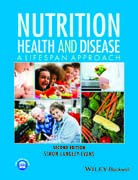
Bringing together key topics in basic science, clinical nutrition, and public health, Nutrition, Health and Disease is an easy–to–read, student–friendly textbook which clearly demonstrates how the body s demand for nutrients changes across throughout life and thus the variety of ways in which nutrition and diet affect health and disease. The second edition of this successful text now includes expanded introductory material to ensure a firm grasp of key concepts, and new content on vegetarian, vegan, kosher and other alternative diets; dieting in adults; gender and nutrition; macro– and micronutrients; a range of new diagrams to support visual learners; and background on nutritional epidemiology and statistics. Nutrition, Health and Disease: A Lifespan Approach is an ideal resource for consolidation of the range of material a student or newly–qualified nutrition or dietetics professional needs to know. INDICE: Preface.Acknowledgements.Abbreviations.Glossary of terms.Chapter 1. INTRODUCTION TO LIFESPAN NUTRITION.1.1 The lifespan approach to nutrition.1.2 The concept of balance.1.3 The individual response to nutrition.1.4 Assessment of nutritional status.1.5 Nutritional epidemiology: understanding diet–disease relationships.1.6 Dietary reference values.Chapter 2. BEFORE LIFE BEGINS.2.1 Introduction.2.2 Nutrition and female fertility.2.3 Nutrition and male fertility.2.4 Preparation for pregnancy.Chapter 3 PREGNANCY.3.1 Introduction.3.2 Physiological demands of pregnancy.3.3. Nutrient requirements in pregnancy.3.4 Diet in relation to pregnancy outcomes.3.5. Nausea and vomiting of pregnancy (NVP).3.6 Cravings and aversions.3.7 Gastrointestinal disturbances in pregnancy.3.8 High–risk pregnancies.Chapter 4 FETAL NUTRITION AND DISEASE IN LATER LIFE.4.1 Introduction.4.2 The Developmental Origins of Adult Disease.4.3 Evidence linking maternal nutrition to disease in later life.4.4 Mechanistic basis of fetal programming.4.5 Implications of the programming hypothesis.Chapter 5. LACTATION AND INFANT FEEDING.5.1 Introduction.5.2 The physiology of lactation.5.3 The advantages of breastfeeding.5.4 Trends in breastfeeding behaviour.5.5 Situations in which breastfeeding is not advised.5.6 Alternatives to breastfeeding.Chapter 6 NUTRITION AND CHILDHOOD.6.1 Introduction.6.2 Infancy (Birth to Five).6.3 Childhood (Five to Thirteen).6.4 Obesity in children.Chapter 7. NUTRITION AND ADOLESCENCE.7.1 Introduction.7.2 Physical development.7.3 Psychosocial development.7.4 Nutritional requirements in adolescence.7.5 Nutritional intakes in adolescence.7.6 Potential problems with nutrition.Chapter 8. THE ADULT YEARS.8.1 Introduction.8.2 Changing needs for nutrients.8.3 Guidelines for healthy nutrition.8.4 Disease states associated with unhealthy nutrition and lifestyle.Chapter 9. NUTRITION, AGEING AND THE ELDERLY.9.1 Introduction.9.2 The ageing population.9.3 The ageing process.9.4 Nutrient requirements of the elderly.9.5 Barriers to healthy nutrition in the elderly.9.6 Common nutrition–related problems.Appendix.A1 Classification of nutrients.A2 Carbohydrates.A2.1 Major roles.A2.2 Structure and classification of carbohydrates.A2.3 Digestion and absorption of carbohydrates.A3 Lipids.A3.1 Major roles.A3.2 Structure and classification of lipids.A3.2.1 Fatty acids.A3.2.2 Phospholipids and triglycerides.A3.2.3 Digestion and absorption of lipids.A4 Protein.A4.1 Major roles.A4.2 Amino acids.A4.3 Structure of proteins.A4.4 Digestion and absorption of proteins.A5 Micronutrients.A5.1 Minerals.A5.2 VitaminsIndex
- ISBN: 978-1-118-90709-2
- Editorial: Wiley–Blackwell
- Encuadernacion: Rústica
- Páginas: 384
- Fecha Publicación: 03/07/2015
- Nº Volúmenes: 1
- Idioma: Inglés
